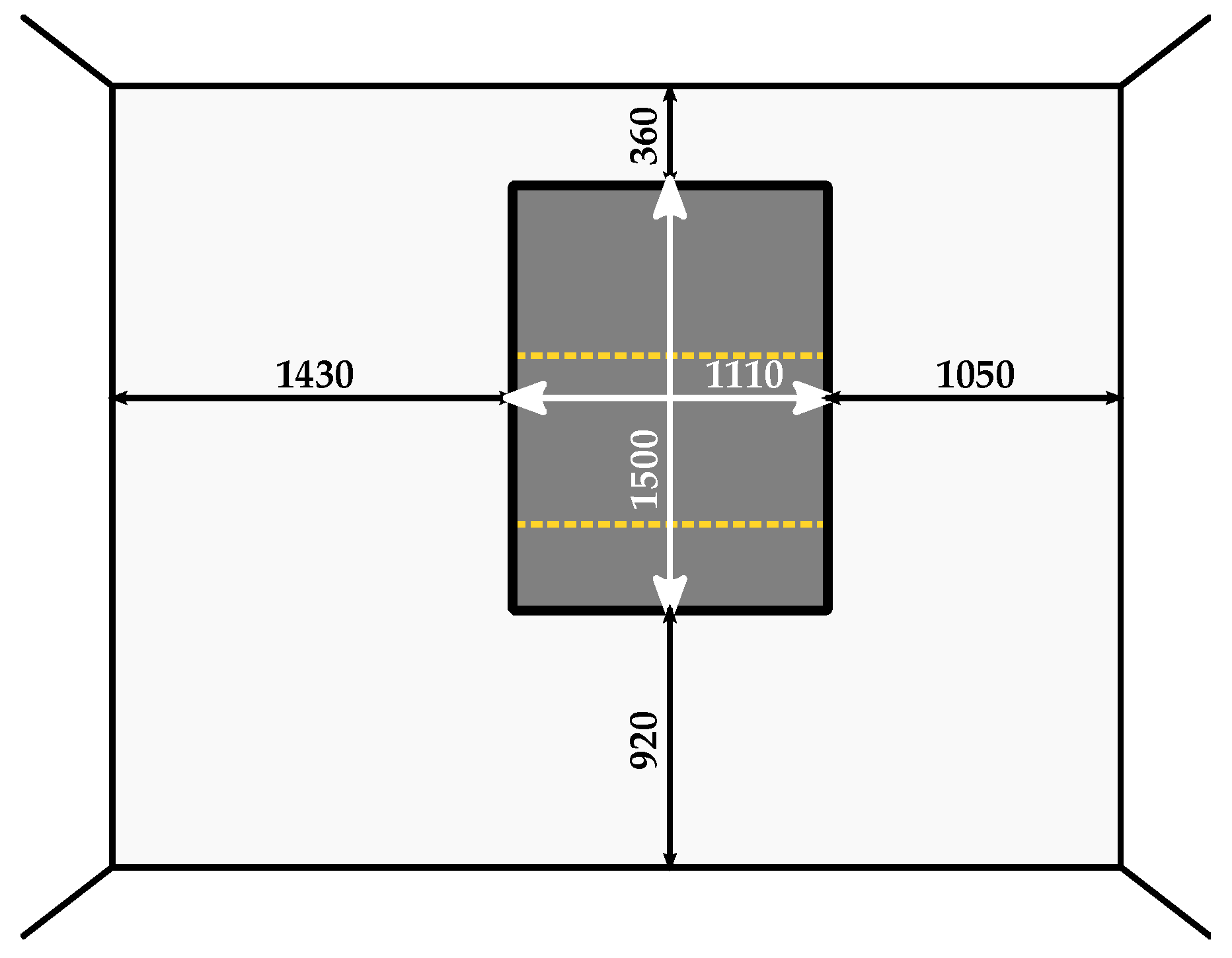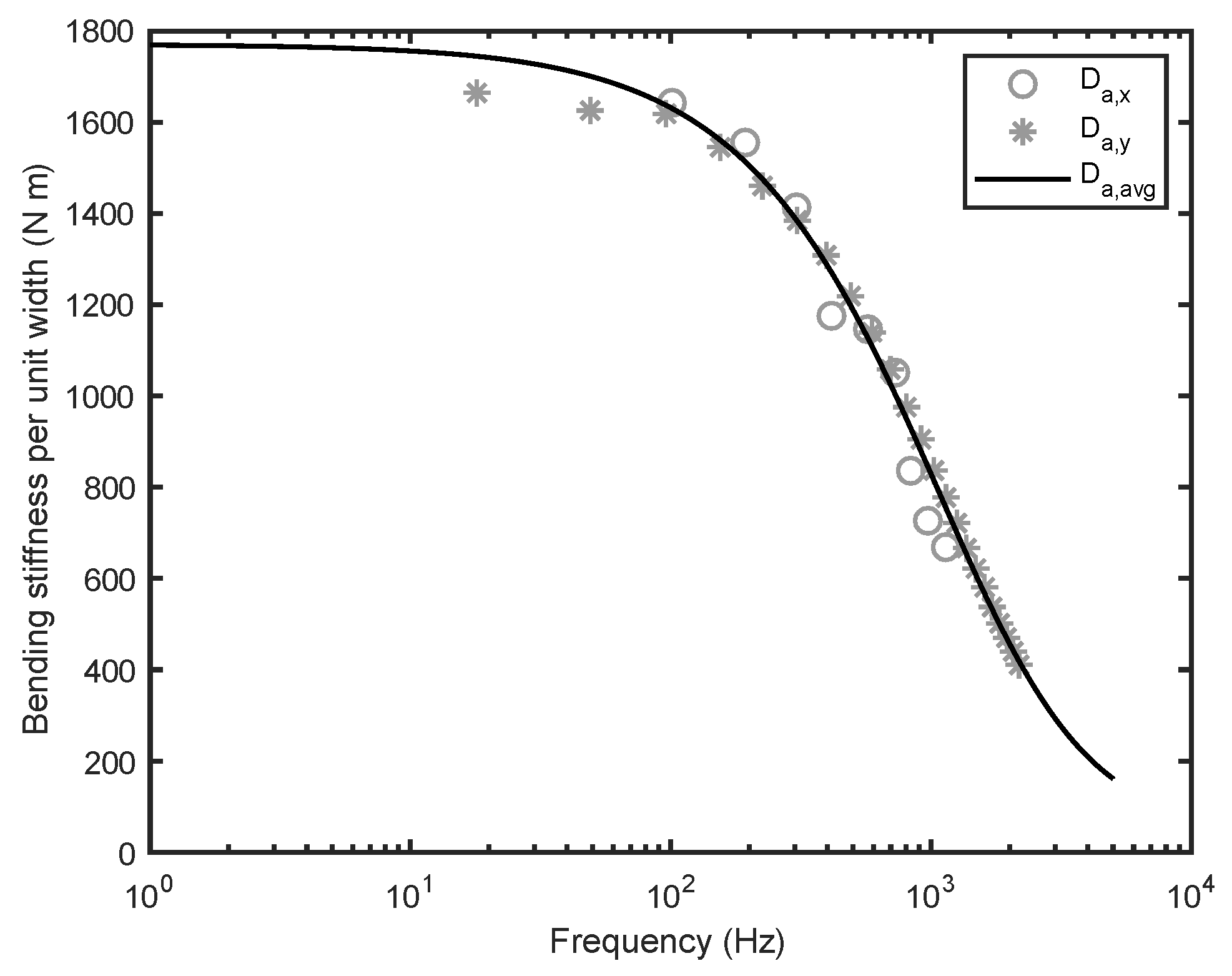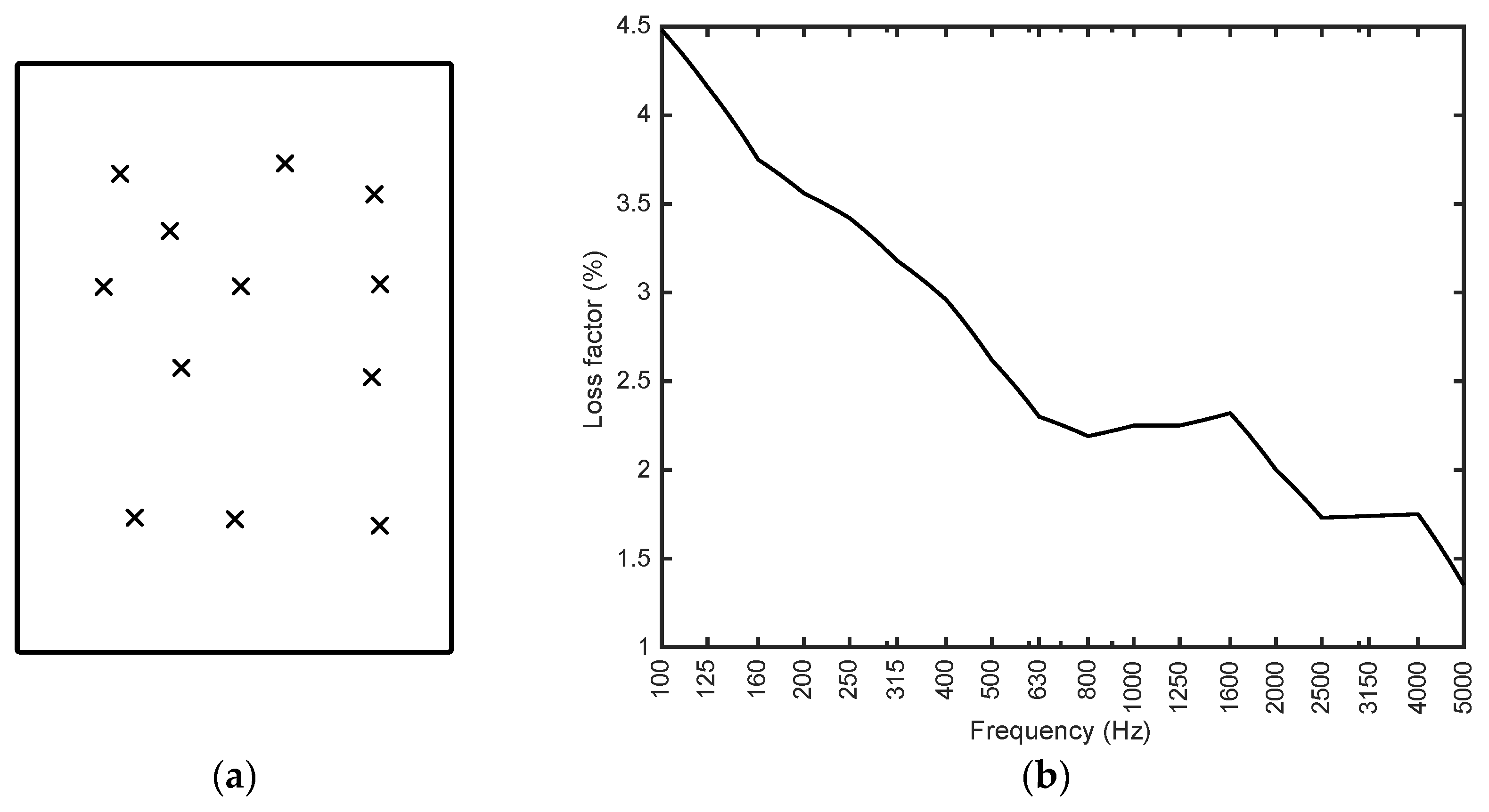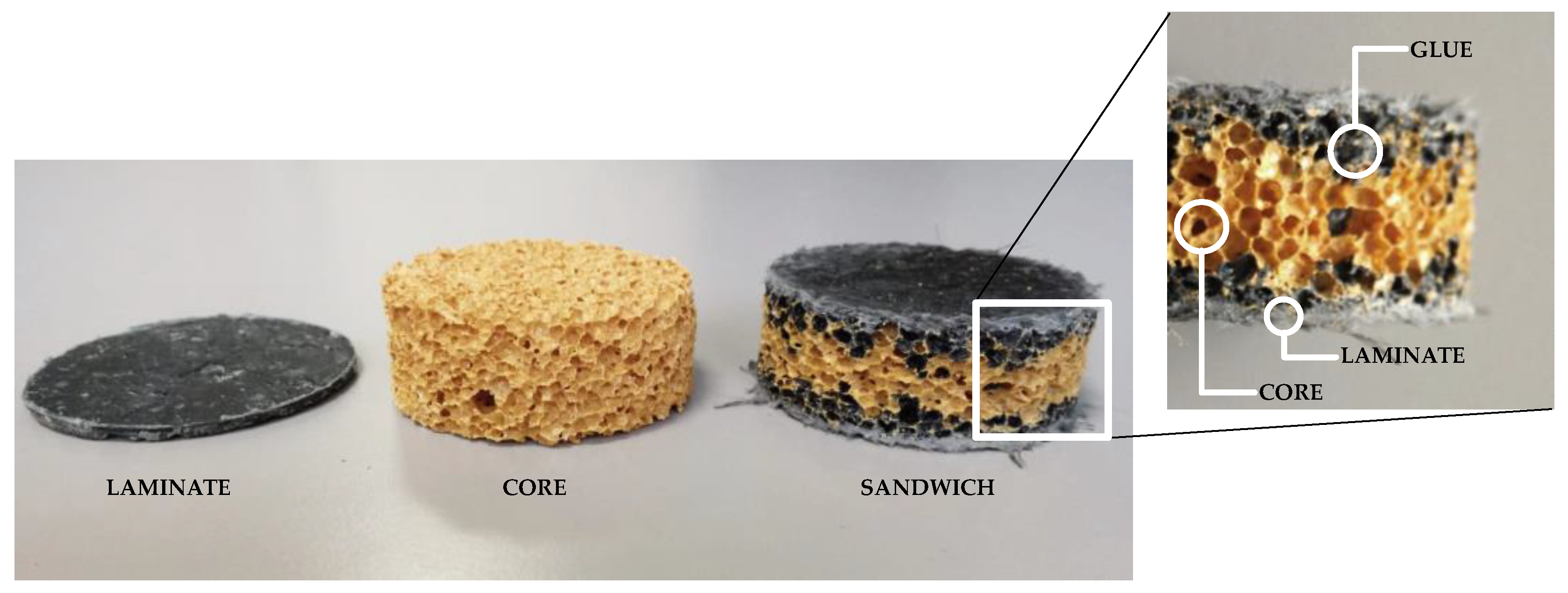Vibro-Acoustic Characterization of a Composite Structure Featuring an Innovative Phenolic Foam Core
Abstract
:Featured Application
Abstract
1. Introduction
2. Theoretical Background
2.1. Propagation of Bending Waves
2.2. Sound Transmission Loss
3. Materials and Methods
3.1. Experimental Determination of the Apparent Bending Stiffness of the Sandwich Panel
3.2. Experimental Determination of Elastic Modulus of the Phenolic Core
3.3. Specimens and Equipment for Dynamic Tests
- two sandwich beams, cut in orthogonal directions from a panel made by a 17-mm open-cell phenolic foam core sandwiched between two identical 1.5-mm SMC leaves (Figure 4); and
- a homogenous 17-mm phenolic foam beam.
3.4. Measurements in Sound Transmission Suites
4. Results and Discussion
4.1. Bending Stiffness of the Sandwich Structure
4.2. Sound Transmission Loss Predictions and Measurements
5. Influence of the Manufacturing Process on the Insulation Properties of the Product
6. Conclusions
Author Contributions
Funding
Acknowledgments
Conflicts of Interest
References
- Yin, C.; Zheng, Q.; Zeng, J.; Yang, J.; Xiao, J. Composite sandwich panel with multifunction of load bearing, heat insulation, and thermal protection. J. Compos. Mater. 2015, 49, 3077–3087. [Google Scholar] [CrossRef]
- Zhu, L.; Liu, W.; Fang, H.; Chen, J.; Zhuang, Y.; Han, J. Design and simulation of innovative foam-filled Lattice Composite Bumper System for bridge protection in ship collisions. Compos. Part B-Eng. 2019, 157, 24–35. [Google Scholar] [CrossRef]
- Amraei, M.; Shahravi, M.; Noori, Z.; Lenjani, A. Application of aluminium honeycomb sandwich panel as an energy absorber of high-speed train nose. J. Compos. Mater. 2014, 48, 1027–1037. [Google Scholar] [CrossRef]
- Mozafari, H.; Khatami, S.; Molatefi, H. Out of plane crushing and local stiffness determination of proposed foam filled sandwich panel for Korean Tilting Train eXpress—Numerical study. Mater. Des. 2015, 66, 400–411. [Google Scholar] [CrossRef]
- Helps, I.G. Plastics in European Cars, 2000–2008; iSmithers Rapra Publishing: Shrewsbury, UK, 2001; ISBN 978-1-85957-234-4. [Google Scholar]
- SAND CORe Co-ordination Action on Advanced Sandwich Structures in the Transport Industries. Best Practice Guide for Sandwich Structures in Marine Applications; NewRail, University of Newcastle: Tyne, UK, 2013. [Google Scholar]
- Shams, A.; Stark, A.; Hoogen, F.; Hegger, J.; Schneider, H. Innovative sandwich structures made of high performance concrete and foamed polyurethane. Compos. Struct. 2015, 121, 271–279. [Google Scholar] [CrossRef]
- Benedetti, M.; Gervasio, P.; Luscietti, D.; Pilotelli, M.; Lezzi, A.M. Point thermal transmittance of rib intersections in concrete sandwich wall panels. Heat Transf. Eng. 2018. [Google Scholar] [CrossRef]
- Di Bella, A.; Granzotto, N.; Elarga, H.; Semprini, G.; Barbaresi, L.; Marinosci, C. Balancing of thermal and acoustic insulation performances in building envelope design. In Proceedings of the INTER-NOISE 2015—44th International Congress and Exposition on Noise Control Engineering, San Francisco, CA, USA, 9–12 August 2015; Maling, G., Burroughs, C., Eds.; The Institute of Noise Control Engineering of the USA, Inc.: San Francisco, CA, USA, 2015. [Google Scholar]
- Mohamed, M.; Anandan, S.; Huo, Z.; Birman, V.; Volz, J.; Chandrashekhara, K. Manufacturing and characterization of polyurethane based sandwich composite structures. Compos. Struct. 2015, 123, 169–179. [Google Scholar] [CrossRef]
- Altenbach, H. Mechanics of advanced materials for lightweight structures. J. Mech. Eng. Sci. 2011, 225, 2481–2496. [Google Scholar] [CrossRef]
- Roozen, N.B.; Leclère, Q.; Ege, K.; Gerges, Y. Estimation of plate material properties by means of a complex wavenumber fit using Hankel’s functions and the image source method. J. Sound Vib. 2017, 390, 257–271. [Google Scholar] [CrossRef]
- Shahdin, A.; Morlier, J.; Gourinat, Y.; Mezeix, L.; Bouvet, C. Fabrication and Mechanical Testing of a New Sandwich Structure with Carbon Fiber Network Core. J. Sandw. Struct. Mater. 2010, 12, 569–589. [Google Scholar] [CrossRef]
- Tang, Z.; Zha, X.; Zu, D. Bending properties of steel faced sandwich composite panels with phenolic foam cores. J. Reinf. Plast. Comp. 2016, 35, 834–852. [Google Scholar] [CrossRef]
- Neri, M.; Pilotelli, M. Data on temperature-time curves measured at chimney-roof penetration. Data Brief 2018, 20, 306–315. [Google Scholar] [CrossRef] [PubMed]
- D’Alessandro, V.; Petrone, G.; Franco, F.; De Rosa, S. A review of the vibroacoustics of sandwich panels: Models and experiments. J. Sandw. Struct. Mater. 2013, 15, 541–582. [Google Scholar] [CrossRef]
- Ghinet, S.; Atalla, N. Vibro-acoustic behaviors of flat sandwich composite panels. Trans. Can. Soc. Mech. Eng. 2006, 30, 473–493. [Google Scholar] [CrossRef]
- Tronchin, L. Modal analysis and intensity of acoustic radiation of the kettledrum. J. Acoust. Soc. Am. 2005, 117, 926–933. [Google Scholar] [CrossRef] [PubMed]
- Roozen, N.B.; Labelle, L.; Leclère, Q.; Ege, K.; Alvarado, S. Non-contact experimental assessment of apparent dynamic stiffness of constrained-layer damping sandwich plates in a broad frequency range using a Nd:YAG pump laser and a laser Doppler vibrometer. J. Sound Vib. 2017, 395, 90–101. [Google Scholar] [CrossRef] [Green Version]
- Mayr, A.R.; Gibbs, B.M. Point and transfer mobility of point-connected ribbed plates. J. Sound Vib. 2011, 330, 4798–4812. [Google Scholar] [CrossRef]
- Garrido, M.; Correia, J.R.; Keller, T. Effects of elevated temperature on the shear response of PET and PUR foams used in composite sandwich panels. Constr. Build. Mater. 2015, 76, 150–157. [Google Scholar] [CrossRef]
- Kim, M.; Choe, J.; Lee, D.G. Development of the fire-retardant sandwich structure using an aramid/glass hybrid composite and a phenolic foam-filled honeycomb. Compos. Struct. 2016, 158, 227–234. [Google Scholar] [CrossRef]
- Densley Tingley, D.; Hathway, A.; Davison, B.; Allwood, D. The environmental impact of phenolic foam insulation boards. Proc. Inst. Civ. Eng. Constr. Mater. 2017, 170, 91–103. [Google Scholar] [CrossRef]
- Roberts, M.W. Finishing the job: The Montreal Protocol moves to phase down hydrofluorocarbons. Rev. Eur. Compar. Int. Environ. Law 2017, 26, 220–230. [Google Scholar] [CrossRef]
- Nilsson, E.; Nilsson, A.C. Prediction and measurement of some dynamic properties of sandwich structures with honeycomb and foam cores. J. Sound Vib. 2002, 251, 409–430. [Google Scholar] [CrossRef]
- Piana, E.A.; Petrogalli, C.; Paderno, D.; Carlsson, U. Application of the wave propagation approach to sandwich structures: Vibro-acoustic properties of aluminum honeycomb materials. Appl. Sci. Basel 2018, 8, 45. [Google Scholar] [CrossRef]
- Ruggeri, P.; Peron, F.; Granzotto, N.; Bonfiglio, P. A Combined Experimental and Analytical Approach for the Simulation of the Sound Transmission Loss of Multilayer Glazing Systems. Build. Acoust. 2015, 22, 16. [Google Scholar] [CrossRef]
- Scamoni, F.; Piana, E.A.; Scrosati, C. Experimental evaluation of the sound absorption and insulation of an innovative coating through different testing methods. Build. Acoust. 2017, 24, 173–191. [Google Scholar] [CrossRef] [Green Version]
- Santoni, A.; Bonfiglio, P.; Mollica, F.; Fausti, P.; Pompoli, F.; Mazzanti, V. Vibro-acoustic optimisation of Wood Plastic Composite systems. Constr. Build. Mater. 2018, 174, 730–740. [Google Scholar] [CrossRef]
- Piana, E.A.; Marchesini, A. How to lower the noise level in the owner’s cabin of a yacht through the improvement of bulkhead and floor. In Proceedings of the 21st International Congress on Sound and Vibration, Beijing, China, 13–17 July 2014; IIAV: Beijing, China, 2014; Volume 5, pp. 3692–3699. [Google Scholar]
- Ichchou, M.N.; Bareille, O.; Berthaut, J. Identification of effective sandwich structural properties via an inverse wave approach. Eng. Struct. 2008, 30, 2591–2604. [Google Scholar] [CrossRef]
- de Rijk, S.; Nijman, E. Equivalent material modelling of sandwich beams, evanescent solutions and damping investigations. J. Sound Vib. 2016, 382, 291–309. [Google Scholar] [CrossRef]
- Cremer, L.; Heckl, M.; Petersson, B.A.T. Structure-Borne Sound: Structural Vibrations and Sound Radiation at Audio Frequencies, 3rd ed.; Springer: Berlin/Heidelberg, Germany, 2005; ISBN 978-3-540-22696-3. [Google Scholar]
- Sharp, B.H. Prediction methods for the sound transmission of building elements. Noise Control Eng. 1978, 11, 53–63. [Google Scholar] [CrossRef]
- Leclère, Q.; Roozen, N.B.; Sandier, C. On the use of the Hs estimator for the experimental assessment of transmissibility matrices. Mech. Syst. Signal P Process. 2014, 43, 237–245. [Google Scholar] [CrossRef] [Green Version]
- Nilsson, A.; Liu, B. Vibro-Acoustics, Volume 2, 2nd ed.; Springer: Berlin/Heidelberg, Germany, 2016; ISBN 978-3-662-47933-9. [Google Scholar]
- Nentwich, F.; Fuchs, A. Acoustic behavior of sandwich plates. J. Sandw. Struct. Mater. 2015, 17, 183–213. [Google Scholar] [CrossRef]
- Ege, K.; Roozen, N.B.; Leclère, Q.; Rinaldi, R.G. Assessment of the apparent bending stiffness and damping of multilayer plates; modelling and experiment. J. Sound Vib. 2018, 426, 129–149. [Google Scholar] [CrossRef] [Green Version]
- Oldenbo, M.; Mattsson, D.; Varna, J.; Berglund, L.A. Global Stiffness of a SMC Panel Considering Process Induced Fiber Orientation. J. Reinf. Plast. Comp. 2004, 23, 37–49. [Google Scholar] [CrossRef] [Green Version]
- Piana, E.A.; Milani, P.; Granzotto, N. Simple method to determine the transmission loss of gypsum panels. In Proceedings of the 21st International Congress on Sound and Vibration, Beijing, China, 13–17 July 2014; IIAV: Beijing, China, 2014; Volume 5, pp. 3700–3706. [Google Scholar]
- Santoni, A.; Schoenwald, S.; Van Damme, B.; Fausti, P. Determination of the elastic and stiffness characteristics of cross-laminated timber plates from flexural wave velocity measurements. J. Sound Vib. 2017, 400, 387–401. [Google Scholar] [CrossRef]
- Bies, D.A.; Hansen, C.H. Engineering Noise Control: Theory and Practice, 4th ed.; CRC Press: London, UK; New York, NY, USA, 2009; ISBN 978-0-415-48706-1. [Google Scholar]
- Piana, E.A.; Petrogalli, C.; Solazzi, L. Dynamic and acoustic properties of a joisted floor. In Proceedings of the SIMULTECH 2016—6th International Conference on Simulation and Modeling Methodologies, Technologies and Applications, Lisbon, Portugal, 29–31 July 2016; Obaidat, M.S., Merkuryev, Y., Oren, T., Eds.; SciTePress: Lisbon, Portugal, 2016; pp. 277–282. [Google Scholar]
- Piana, E.A. A method for determining the sound reduction index of precast panels based on point mobility measurements. Appl. Acoust. 2016, 110, 72–80. [Google Scholar] [CrossRef]
- Nilsson, A.; Baro, S.; Piana, E.A. Vibro-acoustic properties of sandwich structures. Appl. Acoust. 2018, 139, 259–266. [Google Scholar] [CrossRef] [Green Version]
- Nilsson, A.; Liu, B. Vibro-Acoustics, Volume 1, 2nd ed.; Springer: Berlin/Heidelberg, Germany, 2015; ISBN 978-3-662-47806-6. [Google Scholar]
- Santoni, A.; Schoenwald, S.; Fausti, P.; Tröbs, H.-M. Modelling the radiation efficiency of orthotropic cross-laminated timber plates with simply-supported boundaries. Appl. Acoust. 2019, 143, 112–124. [Google Scholar] [CrossRef]
- Leppington, F.G.; Heron, K.H.; Broadbent, E.G.; Mead, S.M. Resonant and Non-Resonant Acoustic Properties of Elastic Panels. II. The Transmission Problem. Proc. R. Soc. A-Math. Phsy. 1987, 412, 309–337. [Google Scholar] [CrossRef]
- Hopkins, C. Sound Insulation, 1st ed.; A Butterworth-Heinemann Title: Amsterdam, The Netherlands, 2007; ISBN 978-0-7506-6526-1. [Google Scholar]












| n | 1 | 2 | 3 | 4 | ≥5 |
|---|---|---|---|---|---|
| αn | 4.73 | 7.85 | 11.0 | 14.14 | nπ + π/2 |
| Characteristic | Homogeneous Beam | Sandwich Beam, x Direction | Sandwich Beam, y Direction |
|---|---|---|---|
| Length L (m) | 1.176 | 1.166 | 1.666 |
| Core thickness hc (m) | 0.017 | 0.017 | 0.017 |
| Laminate thickness hl (m) | - | 0.0015 | 0.0015 |
| Width b (m) | 0.05 | 0.05 | 0.05 |
| Mass per unit area μ (kg m−2) | 3.02 | 8.38 | 8.45 |
| Young’s modulus of the laminates El (MPa) | - | 9000 | 9000 |
| Characteristic | Value |
|---|---|
| Free test opening H × L (m) | 1.500 × 1.110 |
| Panel size H × L (m) | 1.490 × 1.110 |
| Core thickness hc (m) | 0.017 |
| Laminate thickness hl (m) | 0.0015 |
| Mass per unit area μ (kg m−2) | 8.45 |
| Young’s modulus of the laminates El (MPa) | 9000 |
© 2019 by the authors. Licensee MDPI, Basel, Switzerland. This article is an open access article distributed under the terms and conditions of the Creative Commons Attribution (CC BY) license (http://creativecommons.org/licenses/by/4.0/).
Share and Cite
Fortini, M.; Granzotto, N.; Piana, E.A. Vibro-Acoustic Characterization of a Composite Structure Featuring an Innovative Phenolic Foam Core. Appl. Sci. 2019, 9, 1276. https://doi.org/10.3390/app9071276
Fortini M, Granzotto N, Piana EA. Vibro-Acoustic Characterization of a Composite Structure Featuring an Innovative Phenolic Foam Core. Applied Sciences. 2019; 9(7):1276. https://doi.org/10.3390/app9071276
Chicago/Turabian StyleFortini, Massimo, Nicola Granzotto, and Edoardo Alessio Piana. 2019. "Vibro-Acoustic Characterization of a Composite Structure Featuring an Innovative Phenolic Foam Core" Applied Sciences 9, no. 7: 1276. https://doi.org/10.3390/app9071276







